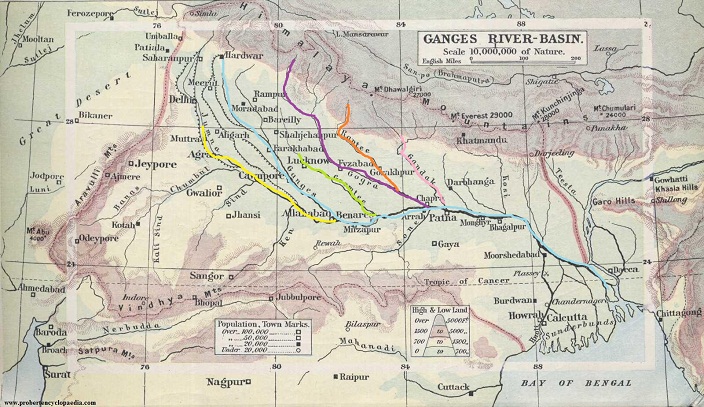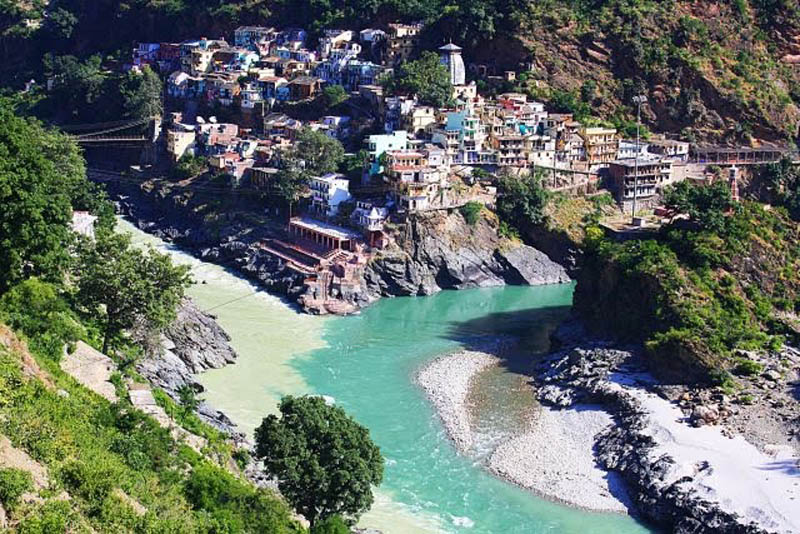 |
http://ccbs.ntu.edu.tw/FULLTEXT/JR-ENG/hoey.htm
What are "the five rivers" of Fa-hian? The Ganga and
Yamuna, the Ganges and the Jamna, are known to everyone; as
also is their confluence at Prayaga, Allahabad. The Sarabhu
is the modern Sarju or Gogra; it is the Sarabos of Ptolemy,
and the Sanskrit Sarayu, on which Valmiki, in Ramayana, i. 5,
6, places the city of Ayodhya. The Aciravati is the Airavati,
the modern Rapti; and when we remember that Airavata was the
elephant of Indra, we see how it is that this system of five
rivers issues from the mouth of an elephant.1 The Rapti
(Aciravati) flows into the Sarju, or Gogra (Sarabhu, Sarayu),
in lat. 26 15', long. 83 42', between Barhaj in the
Gorakhpur district and Dharampur in the Azamgarh district;
and the united two rivers flow into the Ganges near Revelganj
in the
-----------------------------
1. The Indus (Sindhu) issues from lion's mouth. Hence that
river is called Sinh ka bab. the lion's gate or mouth.
p. 44
Saran district. 1 Finally, the river which is now known as
the Mahi flows actually into the Gandak, the Great Gandak,
about half a mile above its junction with the Ganges, but
practically into the Ganges, near Sonpur (Sonepore), in the
same district.
Regarding this latter river, the Mahi, which is not so
well known as the others, I must make the following
observations. The identity of it was not known to me when I
wrote in J.A.S.B., 1900. 74 ff., about the location of
Vaisali. The first clue was given to me by a Resident
Engineer of the Bengal and North-Western Railway, who
reminded me that, on its course from Sewan to Paleza Ghat,
the line crosses a river shown in the railway-map as
'Mhye.'(2) And he informed me that, when he was surveying for
the alignment, there was trouble with the learned and
priestly Brahmans of the locality, who claimed that the name
Mahi should be retained, instead of being replaced by that of
another river, the Gandaki, which flows into it. But the
identity of the Mahi does not rest upon only the information
so given to me. The river is mentioned as the "Mahi nadi" in
the Statistical Account of Bengal, 11 (1877). 358, as
intersecting the Kasmar pargana of the Saran district; and
-----------------------------
1. It's to be noted that at a point about sixteen miles above
the confluence of the Gogra and the Rapti, and near a
place called Muhoolah, just west of Dohri, in the Azamgarh
district, there branches off to the south and south-east a
river,.shown in Indian Atlas Sheet No. 103 as 'Surjoo
Suddee,' which flows into the Ganges at Ballia. It is not
an insigniticant stream; the Gazetteer of the Ballia
district tells us, on p. 128, that it is "navigable for
large country vessels for five or six months in the vear
and for small boats all.the year round." And it may be
added that, at the place where this river leaves the
Gogra, the latter river has to be strongly embanked and
protected by spurs to beep it to its present course. The
plans and estimates have passed through me officially. In
fact, the people of the Azamgarh and Ballia districts
allege that the 'Surjoo Nuddee' runs in the original bed
of the Gogra, and it is feared that the latter river may
so break its present south hank as to return wholly to its
old course. It is not impossible that in ancient times,
and in fact in the davs of Fa-hian and Hiuen Tsiang, this
Sarjh Nuddee was the real bed of the Gogra; that there was
then no stream between Muhoolah-Dohri and Barhaj; and that
consequently the Gogra had its confluence with the united
Ganges and Jamna at Ballia, and the Rapti had its own
separate confluence with the united three streams near
Revilganj. I show the Surjoo Nuddee by a dotted line in
the annexed sketch-map.
2. This form was evidently borrowed from the same form estab-
lished many long years ago in the case of the river Mahi of
Western India, which flows into the Gulf of Cambay.
p. 45
that though its total course is only some forty to forty-five
miles, it's not an insignificnt stream, is shown by the facts
there stated, that it's navigable for boats of 600 maunds all
the year round and that during the rains boats of all sizes
can go up it. Further, the whole course of the Mahi with the
name attached throughout is shown in the Bengal Survey Sheets
Nos. 83, 84, 113, and 114, of 1902 to 1904.1 The Mahi leaves
the Gandak, the Great Gandak, at Sarangpur, 2 in lat. 26 9',
long. 84 58', about eleven miles towards the south-east from
Dighwa-Dubauli, well known as the find-place of an ancient
copper-plate record (I.A., 15. 105). Flowing through a cut in
the Saran embankment on the south of the Great Gandak, and
passing a large village called Amnaur, it comes eventually to
Sitalpur, about nineteen miles on the east of Chhapra. There
it receives the waters of the Gandaki. And, the latter river
then losing its own name, the two united rivers flow on under
the name of the Mahi into the Gandak, or, as said above,
practically into the Ganges.
Whether the Mahi of the present day is the ancient
Mahi-that is, whether its bed marks the original riveris
perhaps open to question. My opinion is that the name is an
ancient name of the Gandak, the Great Gandak; that the latter
river was flowing along its present course in the times of
Fa-hian and Hiuen Tsiang; and that in the modern Mahi we have
a branch, or an overflow-channel, of the Gandak, by transfer
to which the ancient name has been preserved. But, however
that may be, it has now been made cl ear that a river known
as the Mahi still exists in the exact locality indicated by
Fa-hian. I append a small map showing the five rivers of the
Buddhists, referred to by Fa-hian. I think it will illustrate
how apt is the simile in the passage quoted from Hardy's
-----------------------------
1. In the Indian Atlas Sheet, No. 103 of 1857, with additions
to 1895, the name Mahi is not shown, and the course of the
river is given under the name of 'Kuthar N (uddee).'
2. There is another Sarangpur exactly 25 miles due west of
this, on the Gandaki.
อจิรวดี
http://en.wikipedia.org/wiki/Aciravati
http://en.wikipedia.org/wiki/West_Rapti_River
สรภู
http://en.wikipedia.org/wiki/Sarayu
| จากคุณ |
:
desmothenes 
|
| เขียนเมื่อ |
:
24 ก.ย. 55 17:01:16
|
|
|
|
 |





